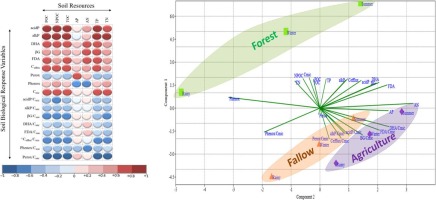Ecological Indicators ( IF 7.0 ) Pub Date : 2020-04-07 , DOI: 10.1016/j.ecolind.2020.106369 Ashutosh Kumar Singh , Xiao-Jin Jiang , Bin Yang , Junen Wu , Apurva Rai , Chunfeng Chen , Jitendra Ahirwal , Pingyuan Wang , Wenjie Liu , Nandita Singh

|
Land use change (LUC) in tropics, explicitly from forest to conventional agriculture, is negatively affecting soil health and productivity. However, effect of such LUC on soil biological properties are poorly known in dry tropical environment. This study aimed to determine the impact of such LUC and climate seasonality on soil biological properties (microbial and enzyme activities), and to also explore the role of soil resources (C, N and P) in driving soil biological properties during this environmental change. Soil biological indicators of topsoil (0–15 cm) were measured on a seasonal basis in the natural forest, fallow and agricultural land. Soil microbial biomass C (Cmic), CO2 efflux (Cefflux) and hydrolytic enzyme activities (acid phosphatase, alkaline phosphatase, β-glucosidase, dehydrogenase, fluorescein diacetate) were generally higher in the forest followed agriculture and fallow. The lower level of these biological variables in agriculture soils were possibly due to lower total soil organic carbon (SOC), labile SOC (particulate OC; POC), total N and P, and cropping disturbance (i.e., fertilization) induced higher inorganic N and P. Whereas, lower biological activities in fallow soils were mainly attributed lower plant activity (i.e. litter production and root activity). In contrast, oxidative enzyme (particularly peroxidase) activities were higher in agriculture followed by the forest and fallow, which might be attributed to higher soil oxygenation from tillage in agriculture and higher persistent SOC (non-particulate OC; NPOC). Seasonal variation in soil biological properties was identical among land uses, though its extent was greater in the forest than fallow and agriculture, indicating LUC can alter the degree of seasonality in biological properties. In addition, the higher specific enzyme activities (i.e., enzyme activities per unit of Cmic) and microbial metabolic quotient (qCO2) in the fallow followed by agriculture and forest, indicating the higher degree of stress on soil microbes after the deforestation than cropping. Whereas, the higher specific enzyme activities and qCO2 in agriculture possibly attributed to higher microbial nutrients demand and lower SOC accumulation. Collectively, our results reveal the significant effects of deforestation and agriculture on soil biological activities and improve our understanding of the potential mechanism driving these effects.
中文翻译:

受干旱地区土地利用变化,土壤资源可利用性和季节性影响的生物指标
热带地区的土地利用变化(LUC),从森林到传统农业,对土壤健康和生产力产生了负面影响。但是,在干燥的热带环境中,这种LUC对土壤生物学特性的影响知之甚少。这项研究旨在确定这种LUC和气候季节对土壤生物学特性(微生物和酶活性)的影响,并探讨在这种环境变化过程中土壤资源(C,N和P)在驱动土壤生物学特性中的作用。在天然林,休耕地和农田中,季节性测量表土(0–15 cm)的土壤生物学指标。土壤微生物生物量C(C mic),CO 2外排(C外排)和水解酶活性(酸性磷酸酶,碱性磷酸酶,β-葡萄糖苷酶,脱氢酶,荧光素二乙酸酯)在农业和休闲后普遍较高。农业土壤中这些生物变量的水平较低可能是由于土壤总有机碳(SOC),不稳定的SOC(颗粒OC; POC),总氮和磷以及耕作干扰(即施肥)引起的无机氮和氮含量降低所致。 P.休耕土壤中较低的生物活性主要归因于较低的植物活性(即凋落物产量和根系活性)。相反,农业中的氧化酶(特别是过氧化物酶)活性较高,其次是森林和休耕地,这可能归因于农业耕作造成的土壤氧合增加和持久性SOC(非颗粒OC; NPOC)升高。土地利用之间土壤生物学特性的季节性变化是相同的,尽管在森林中其程度大于休耕和农业,这表明土地利用变化可以改变生物学特性的季节性程度。另外,较高的比酶活性(即每单位碳的酶活性麦克风)和微生物代谢商(QCO 2)在休耕其次是农业和森林,表示森林砍伐比裁剪后对土壤微生物的更高程度的压力。而农业中较高的比酶活性和qCO 2可能归因于较高的微生物养分需求和较低的SOC积累。总的来说,我们的结果揭示了森林砍伐和农业对土壤生物活动的重大影响,并加深了我们对驱动这些影响的潜在机制的理解。











































 京公网安备 11010802027423号
京公网安备 11010802027423号